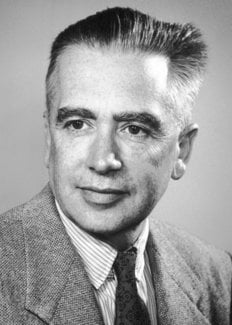Emilio Segrè
Biographical

Emilio Segrè was born in Tivoli, Rome, on February 1st, 1905*, as the son of Giuseppe Segrè, industrialist, and Amelia Treves. He went to school in Tivoli and Rome, and entered the University of Rome as a student of engineering in 1922. In 1927 he changed over to physics and took his doctor’s degree in 1928 under Professor Enrico Fermi, the first one under the latter’s sponsorship.
He served in the Italian Army in 1928 and 1929, and entered the University of Rome as assistant to Professor Corbino in 1929. In 1930 he had a Rockefeller Foundation Fellowship and worked with Professor Otto Stern at Hamburg, Germany, and Professor Pieter Zeeman at Amsterdam, Holland. In 1932 he returned to Italy and was appointed Assistant Professor at the University of Rome, working continuously with Professor Fermi and others. In 1936 he was appointed Director of the Physics Laboratory at the University of Palermo, where he remained until I938.
In 1938 Professor Segrè came to Berkeley, California, first as a research associate in the Radiation Laboratory and later as a lecturer in the Physics Department. From 1943 to 1946 he was a group leader in the Los Alamos Laboratory of the Manhattan Project. In 1946 he returned to the University of California at Berkeley as a Professor of Physics, and still occupies that position.
The work of Professor Segrè has been mainly in atomic and nuclear physics. In the first field he worked in atomic spectroscopy, making contributions to the spectroscopy of forbidden lines and the study of the Zeeman effect. Except for a short interlude on molecular beams, all his work until 1934 was in atomic spectroscopy. In 1934 he started the work in nuclear physics by collaborating with Professor Fermi on neutron research. He participated in the discovery of slow neutrons and in the pioneer neutron work carried on in Rome 1934-1935. Later he was interested in radiochemistry and discovered together with Professor Perrier the element technetium, together with Corson and Mackenzie the element astatine, and together with Kennedy, Seaborg, and Wahl, plutonium-239 and its fission properties.
His other investigations in nuclear physics cover many subjects, e.g., isomerism, spontaneous fission, and lately high-energy physics. Here he, his associates and students have made contributions to the study of the interaction between nucleons and on the related polarization phenomena. In 1955 together with Chamberlain, Wiegand, and Ypsilantis he discovered the antiproton. The study of antinucleons is now his major subject of research.
Professor Segrè has taught in temporary appointments at Columbia University, New York, at the University of Illinois, at the University of Rio de Janeiro and in several other institutions. He is a member of the National Academy of Sciences (U.S.A), of the Academy of Sciences at Heidelberg (Germany), of the Accademia Nazionale dei Lincei of Italy, and of other learned societies. He has received the Hofmann Medal of the German Chemical Society and the Cannizzaro Medal of the Italian Accademia dei Lincei. He is an Honorary Professor of San Marcos University in Peru and has an honorary doctor’s degree of the University of Palermo, Italy.
Professor Segrè is married to Elfriede Spiro; they have a son, Claudio, and two daughters, Amelia and Fausta.
This autobiography/biography was written at the time of the award and first published in the book series Les Prix Nobel. It was later edited and republished in Nobel Lectures. To cite this document, always state the source as shown above.
*In his autobiography A mind always in motion: The autobiography of Emilio Segrè, Emilio Segrè writes that he was born on 30 January 1905. However, his arrival was reported later than prescribed by law, and to avoid complications 1 February 1905 was registered as his official birthday.
Emilio Segrè died on April 22, 1989.
Nobel Prizes and laureates
Six prizes were awarded for achievements that have conferred the greatest benefit to humankind. The 14 laureates' work and discoveries range from quantum tunnelling to promoting democratic rights.
See them all presented here.
